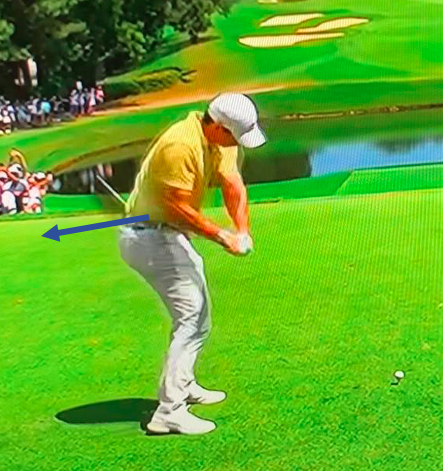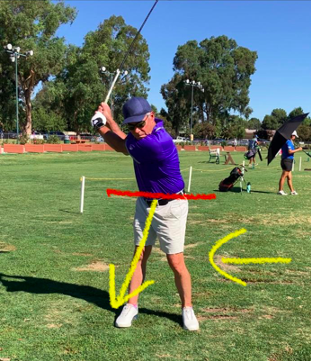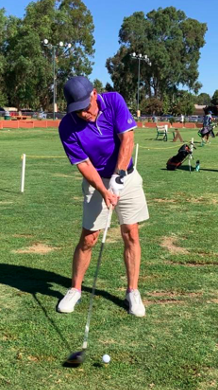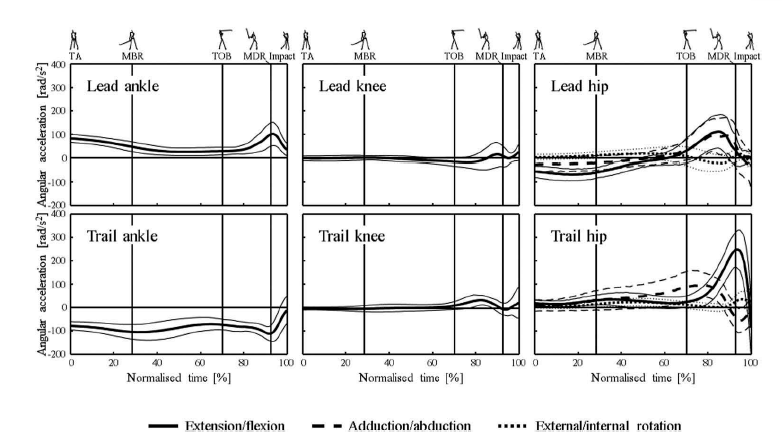Rory McIlroy and Low Back Spasms during Tour Championship, August 2023.
A Golf Channel announcer stated that Rory tweaked his low right side back during a gym session on Tuesday 22nd.
When interviewed on Friday 25th Aug. 2023, he said that his numbers were, “Half club off. Hard to get right side through ball. Better with longer clubs because more upright. With the shorter stuff (clubs) trying to stay in my posture is a struggle. So coming out of it, just swinging my arms at it, and missing a lot of iron shots left. Tried to manage it and did the best I could.”
“Rory, What can you do? What are you limited with?” asked a reporter.
“Can’t hit the ball left to right. Can’t swing my irons the way I want to, can’t turn my right side through the ball. From the top of the swing just throwing my arms at it… Can only hit it one way with the irons. Can’t hit the driver the way I usually do, just teeing down my driver and hitting a flat little runner. Missing irons shots left because hard to staying posture.”
INJURY/PAIN: The probable causes of Rory’s issues at Lumbar Spine/Low Back
Too much right side bend combined with rotation – esp. as it’s made at high speed. [screen shots from live TV coverage during Tour Championship itself] 
PERFORMANCE: Causes of Rory’s occasional left-right misses under pressure
If you watch Rory at a driving range next to a bunch of other pros, he makes them look like beginners, his ball striking is so pure, his ball so well-compressed. But he leaks balls slightly left or right, even during practice.
The SIGN that a swing will randomly miss left or right under pressure is when the trail (right) elbow points to behind the golfer pre-impact (see picture below), but points down-the-line at a position just post-impact (see picture above and blue arrow pointing down-the-line). When the trail elbow points down-the-line at impact, it is an indication of trail fore-arm rotation. This could result in an unpredictable rate of closure.
The trail elbow is just a visual sign of what not to do. Ideally, at impact, the upper-torso/thorax should be very slightly closed to target so that the trail forearm cannot rotate until well past impact, ensuring a square clubface.

SWING SOLUTIONS for INJURY and PERFORMANCE
During those very same days, Phil F. (69 yrs) visited me from Maryland as he had had microdiscectomy for L5-S1 disc bulge and numbness caused by pinched nerves. He was two months post surgery. We worked on his full swing and short game for 6 days.
INJURY SOLUTIONS: Minimally flexed hips at address and throughout backswing as well as least possible knee flexion and pelvis rotation during backswing (see screen shot below) allowed for less strain on the low back from
- More upright spine
- Less rotating-in-downswing lumbar spine
- Less side-bending lumbar spine in downswing
(The above are the three main researched causes of lumbar disc herniation: see my LPGA Master Thesis for details, link on home page of this website)

PERFORMANCE SOLUTIONS:
This STABLE BACKSWING allows the big muscles to fire forcefully (trail latissimus dorsi, pectoralis major, serratus anterior and external oblique) off firmly planted legs for better performance.
[Compare excessive PRE backswing with very stable POST backswing in the picture below]

The result? STRONG, POWERFUL, BALANCED IMPACT!

AND JUST FOR FUN:
At the start of every day, a Sportsbox AI video was taken, on day 1 using his 7 iron and on day 5 using his 8 iron. The results:

Moral of the story from the above results:
BIG MUSCLES DOING THEIR JOB!
Note – results varied, not all were so much better, but all the most recent days were more than that of the first day with the existing swing.
What could have caused his pain? (FOR THE NERDS ONLY)
While we cannot be sure what the causes of Rory’s pain were without a detailed history and exam, here are some thoughts on the subject:
When was the pain first felt?
Talksport.com reported Rory speaking after his round on Thu. 24th August: “I was at the bottom of a squat, a body-weight squat, and my whole lower back spasmed, seized up. I couldn’t move. I honestly couldn’t address the ball this time yesterday,” McIlroy said.
On the same day, Sports Illustrated said Rory explained how he first developed the injury: “It’s a muscle spasm that’s being protective of, you know, like my ribs, joints, everything,” McIlroy said. “I think when I play a lot of golf, especially the end of the season, I always have to manage my right side,” he said. “My right side always gets pretty tight, my rib cage, intercostals, lats, like, all the way down, right hip.
On the other hand, golf.com stated in a report on 27th August: Early in the week, McIlroy revealed that he’d injured his back on Monday in an unexpected way: throwing his daughter Poppy in a pool while relaxing with his family
Very confusing basic information on the inciting incident!
Whatever actually happened it is obvious he has had right side pain – from ribs down for some time now. Thus a more chronic, probably overuse, than acute, issue.
If he did feel pain at the bottom of a body weight squat, the reason is he was beginning to engage his powerful gluteal and hamstring muscles to rise up by extending his hips.
While all my previous research has shown that the three main causes for lumbar disc injury are forward flexion, side bend and rotation, especially at great speed, could hip extension or resisting it in the name of avoiding early extension, followed by forceful, late body rise be another one?
About hip flexion/extension:
1. One study (Changes in hip and spine movement with increasing running speed. (2019). Tojima et al) says that when runners have limited hip extension at toe off (similar to right leg trying to not early extend till late in the downswing), there is extensive lumbar extension to compensate for the restricted hip motion at toe off. This causes low back pain in runners as does the repetition of excessive lumbar extension and rotation. ALL of which Rory does to make a currently-considered text-book swing close to impact. He does consider it important to ‘try to stay in his posture” as describe at the beginning of this post.
2. A superb and recent study, “Dynamics of pelvis rotation about its longitudinal axis during the golf swing” (2021, by Takagi et al.) found that most pelvic angular acceleration comes from active (muscle work) joint torque. It also found that of the lead and trail ankle, knee and hip joints, the maximum joint torque came from trail hip extension (downward curve in figure below) and that trail hip extension contributed the most to pelvis axial (i.e. on a horizontal plane or rotary) angular acceleration. In other words, trail hip extension is important for pelvis rotation which is a big contributing factor to the eventual generation of club speed (see figures below).


Interestingly, the paper found that peak trail hip extensor torque happens at an average of 85% into the pelvis’ downswing motion from the time of transition to the time when it has attained its maximum velocity. So, it is happening late in the downswing – another sign that golfers are trying to avoid early extension?
3. Another research study looked only at “Hip joint torques during the golf swing of young and senior healthy males” ((Foxworth et al., 2013). By far the largest (internal) peak hip torque for both young and old was the trail hip extensor torque. [Note: All the net joint torques were all normalized to a percent of body weight x height. (see table below).]

In conclusion:
Overall it may be seen that in a typical swing, these is a lot of trail hip extension torque (a force used to rotate a body segment), which could just be a big issue for Rory’s current pain injury. Do golfers have to have a big forward flexion of the hips at address and try to avoid early extension until as late in the downswing as possible? At a time when the torque generated would be high as would the speed of the movement? ABSOLUTELY NOT!


